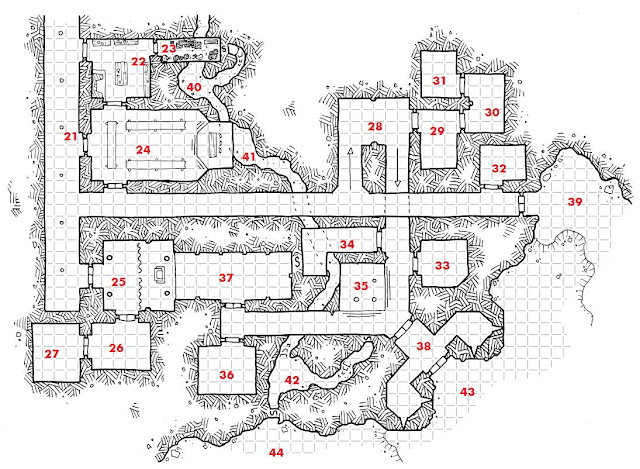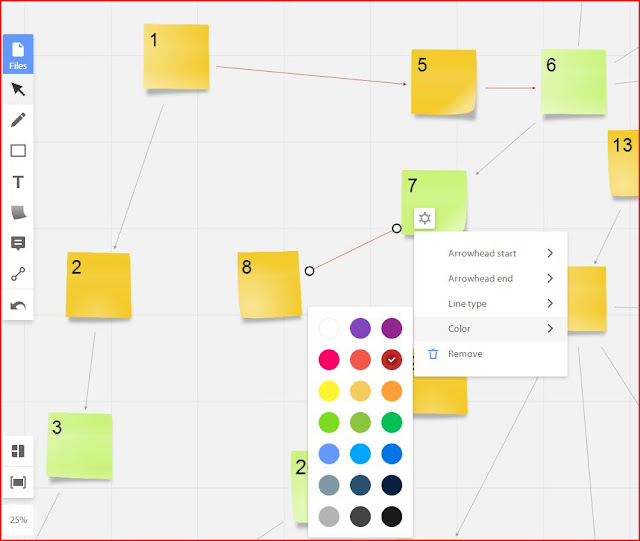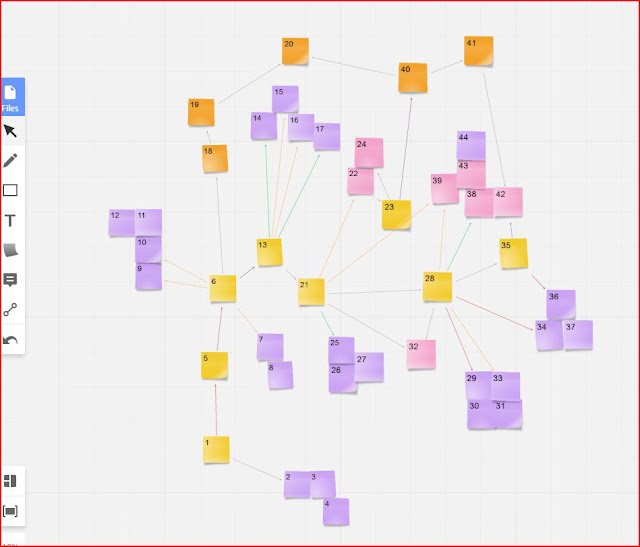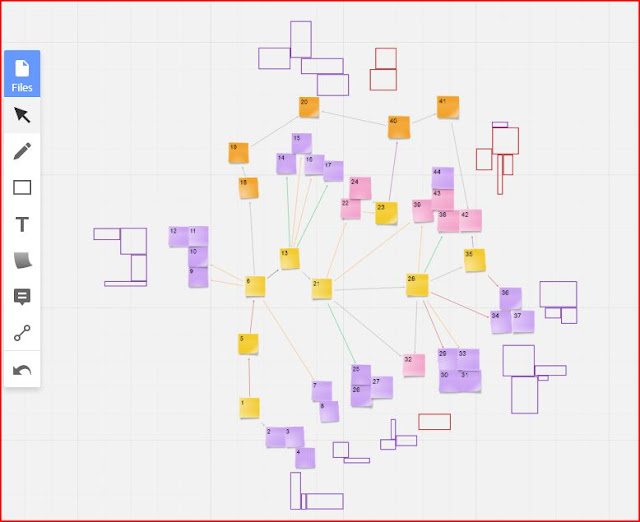This'll be the starting region for the campaign, near the town of Treetombs at the edge of the Deadwood Basin in the kingdom of Blackwater.
Alderspring (Pop. 1,250)
Points of Interest: Blood Keep (castle), Deepwater (village), Rightblood Ranch (ranch), Scrubthorn (village), the Sunstone (lighthouse)
Alderspring is cattle country. The sacred bulls slaughtered in temples across the Wolf Sea are calved in the great herds of red and silver-coated cattle in the uplands. Fuligin-robed Deadwalkers of the Dismal Land, wolf-robed Krovi tribunes and the sorcerer-overseers of the Low Wyvs can all be found lodged in Deepwater, despite direct orders from the New King forbidding Baron Alderspring to do commerce with them. The baron sells the cattle for cash in hand, and uses the money to pay mercenaries to keep the New King's men out of his business. He sells sacred cattle on the sly to the Old King to placate his undead warriors, though it's an open secret and only a matter of time before he's caught. He is plagued by cattle-rustlers and an unusually large number of wolves, both of which he blames on the baroness of Redcrossing. Rumours abound that the Low Wyvs are building a gate in the hills to directly transport the bulls home without the need of ships, though where they would get a sufficiently large supply of human bone to do so is anyone's guess.
The Cinder
Points of Interest: Baroness Redcrossing's Schola (shrine), the Boiling Sands (lair), the Bone Gate (landmark), the Cinder (Crater), the Corundrum Gate (landmark), the Hecatomb (lair), the Onyx Gate (landmark), the Reclusium of Arvil (tower), the Tomb of Justin IV (shrine/graveyard), the Weeping Tree Labyrinth (dungeon)
The site of the Catastrophe, where the Old King's attempt to attain divinity as an immortal lich released the Grey Death across what was once "Greenwood Basin". The air is pungent with befouled geomancy. Somewhere in the stone flats lays the circle of thirteen petrified sorcerers standing around the great crater. The Cinder has great nodes of the precious black serpentine created during the Catastrophe, and sorcerers are constantly hiring foolish adventurers to recover even a mere handful for use in their experiments. The Grey Death has mostly dissipated, but a few smoldering cracks still release gusts of it now and then. A few necromancers and witches linger in the area personally, as do various beasts twisted by the Grey Death into vicious monsters.
Deadwood Basin
Points of Interest: the Bastion of the Keen Ones (tower), the Burning Place (graveyard), the Lair of Many-Headed Hythax (lair), the Mother's Tear (shrine), Hammerdell Keep (ruin), Lonely Keep (ruin), Oakbend (ruin), the Sleeping Hill (dungeon), Splitstone (ruin), the Trembling Ground (lair), Woodweir (ruin), the Wyvish Locus (landmark)
Deadwood Basin was once the country's breadbasket, densely populated with small villages and keeps. Since the Grey Death came nearly a century ago, the region has been unpopulated and almost nothing will grow there. The area is spotted with ruins from prior epochs - geomantic locuses from the Wyvish Synod, ruined keeps from the Weaver Kings, and buried remnants of the Dragontime. A few tribes of Bonewarped have come down off of Dead Dragon Mountain over the years, and survive by unknown means amongst the ruins. The Old King's hordes are mostly deployed holding ruins across Deadwood, though why he is focused on this instead of reconquering his kingdom is unclear to the living.
God's Eye (Pop. 1,000)
Points of Interest: Gib Hill (village), God's Eye Observatory (shrine), Marro's Grave (village), Tenbarrows (village)
The God's Eye Observatory will soon be the newest temple to the Divine Architect. Most of the villages and farms have sprung up in the past ten years from the construction, and the priests have purified the soil to the best of their abilities. The merchants in Treetombs have expressed an interest in the priests repeating the process in the barrens surrounding Treetombs, but the priests have refused to do so until they finish their temple. Controversially, the temple was built using black serpentine blocks for its foundation, making it a powerful geomantic node, but one that could easily become tainted without careful maintenance. The New King is a patron of the cult of the Divine Architect, and the new bishop has had to divert workers from finishing the temple to throwing up palisades and fortifications in case the Old King turns his attention from Deadwood Basin back to the coastal settlements.
Old Kingshall (Pop. 500)
Points of Interest: Beggar's Hill (village), Cattle Market (city ruin), the Eternal Keep (lair), the Fleeing Village (ruin), the Garden of Statues (lair), the Grain Market (city ruin), the Grey Palace (dungeon), Fatcoin Alley (city ruin) Kingshall College (city ruin), King's Lake (lake), the Late Seer's Village (ruin), Lord's Lane (city ruin), the Lost Man's Square (city ruin), the Man-Eater's Rest (lair), Old Markill (ruin), One-Girl Village (ruin), the Poor Quarter (city ruin), the Praying Village (ruin), the Sleepless Tree (lair), Smiths' Lane (city ruin), Stove's Waystation (village), the Tablet of the Grey Death (landmark), the Tomb of Theophora II (graveyard), the Vile Guard (tower), the Wailing Village (ruin), the Watchful Mother (shrine)
Once the capital of the kingdom of Blackwater, Kingshall is now a collection of petrified ruins haunted by the livind dead. The Old King attempted to ascend to lichdom a century ago, but the ritual went awry and released a magical force known as the "Grey Death" which spread across much of Deadwood Basin. It petrified thousands, killed thousands more, and created a vast wave of refugees whose settlement still determines the population distribution of Blackwater. Lingering traces of it in the earth have prevented the resettlement of Deadwood Basin. The Old King was thought dead, killed in the ritual, and a nephew ascended to the throne to rebuild Blackwater.
Two years ago, black-cloaked envoys went out across Deadwood Basin, announcing that the Old King's ritual had succeeded, and that he intended to return to his throne in Kingshall. His armies of wights and skeletons have mostly spent their time occupying the ruins across Deadwood Basin, and the nobility is split over whether to back him or the descendant of his nephew (now known as the "New King"). The coastal communities have yet to bear the brunt of his armies yet, but most expect it's only a matter of time.
Redcrossing (Pop. 2,000)
Points of Interest: Crowshine (lighthouse), Dunhill (village), Drybridge Keep (castle), Lair of the Lying Wolf (lair), Northcut (village), Redcrossing Ranch (ranch), Southcut (village)
Redcrossing mainly survives off selling produce and sheep to Treetombs. Drybridge Keep was built before the Catastrophe, but the barony is the result of a landgrab by the baroness' ancestors in the chaos immediately afterwards. The baroness of Redcrossing is a powerful sorceress of the Red and Bone Learning who keeps a schola with a handful of apprentices out closer to the Cinder. She pays handsomely for samples of black serpentine. Baron Alderspring blames her for the wolves that plague his herds, though no one knows what her motive might be. Redcrossing is the home base for the High Bailiff of the Stone Coast and his officials and mercenaries, and has become a strategically important site almost accidentally after the Old King declared his intentions. Redcrossing is nominally loyal to the New King due to the official presence, but sympathies amongst the peasantry are strongly in favour of the Old King.
Sharpwater (Pop. 3,000)
Points of Interest: Alderson's Ranch (ranch), Blade Valley (village), Burnt Barrows (ruin), David's Grave (village), Grass Hill (village), Kingshead (village), Pinebridge (village), Poplar Hill (village), Riverwatch (castle), Saltcliff (village), Storm's Sigh (shrine), West Reach (village), Whitebend (village), Wyvman's Rest (landmark)
Sharpwater is the most important barony in the area, both economically and militarily, but it hasn't yet declared for either king. Baron Sharpwater and the merchants of the port of Saltcliff were important local patrons of the God's Eye. He wouldn't want to see the temple razed, but his family was much more prominent in the days of the Old King, and the lich's envoys have promised him a return to greatness if he bends the knee. Popular sympathy is firmly with the New King, and he risks a revolt if he backs the wrong side. Sharpwater is home to the most prominent local shrine to the Unknowable Sea, and has two good ports, making it an important shortcut for merchants trying to avoid tolls on the Great Road and captains who want to avoid trouble at sea. The merchants of Saltcliff are the main rivals of the cartel that runs Treetombs, and they are always looking for ways to further impoverish the town.
Treetombs (Pop. 5,250)
Points of Interest: Blackstone (village), the Dragon's Stairs (landmark), Hulthar's Folly (ruin), the Oak Synod (graveyard), Treetombs (town)
Treetombs is still the economic hub of the region, despite its decline from the days before the Catastrophe, when it was a major city connecting Kingshall to its ports on the Stone Coast. The land surrounding the town is poisoned by the Grey Death, making farming difficult. Still, it survives partially due to its market charter, which negates the tolls and excises of anyone traveling to Treetombs along the Great Road. The town is run by a cartel of free merchants who unite only to crush opposition to their rule. They have bent the knee to the Old King, though he hasn't actually done more than send a small squadron of skeletal warriors into the hills around the town. Treetombs has small shrines to the Great Mother and Divine Architect, and most of the region's professionals and specialists call it home. It's also a popular place for exiles, bandits, mercenaries and ne'er-do-wells to lay low in, as the High Bailiff rarely comes to town. The town gets its name from the nearby (now petrified) Oak Synod, a graveyard from the days of the Wyvs, who entombed their magnates within the hollows of great oaks. The Old King's soldiers have recently begun cutting down the oaks to revive the bodies within, to great outcry from the residents of Treetombs.



























